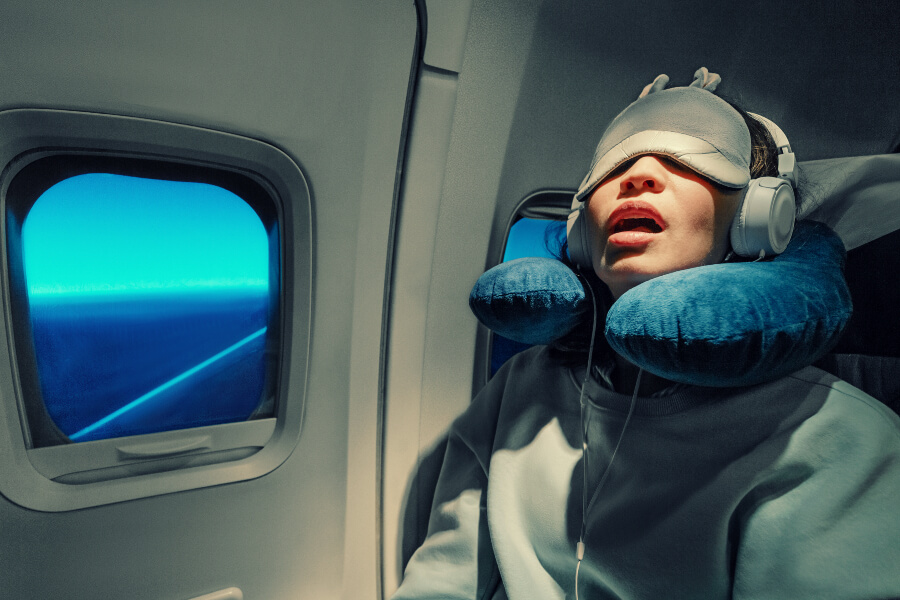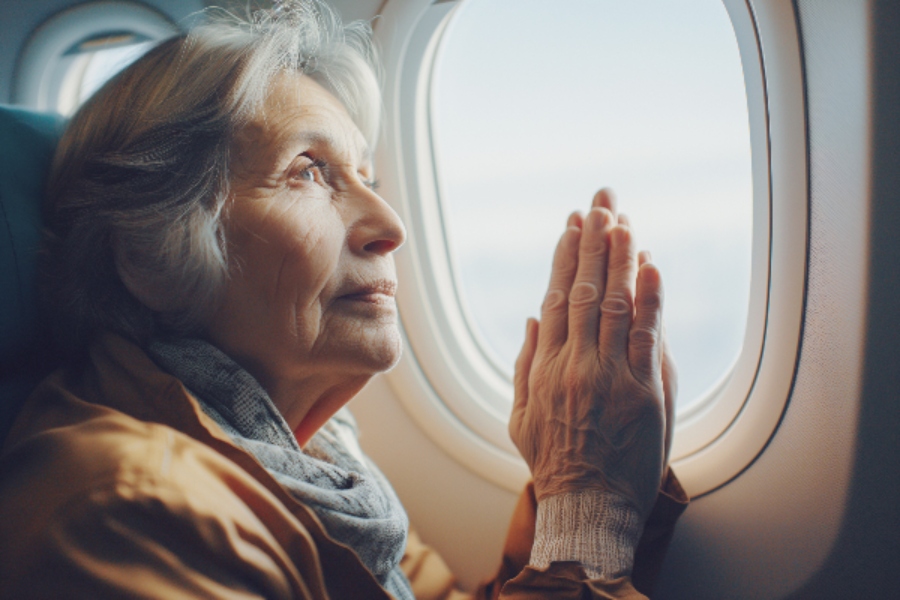Talk about a buzzkill. Anyone who’s ever experienced jet lag knows that brutally bushed feeling associated with long-distance travel, whether you’ve just arrived at your destination or are coming home in a kind of coma.
Jet lag can occur after crossing several time zones quickly. According to the Mayo Clinic, it’s caused by a kink in our circadian rhythms—the body’s internal sleep/wake cycle, that’s still synced to our original time zone. If you don’t get adequate daylight when your body is accustomed to it receiving it, the pineal gland releases the hormone melatonin, making you inappropriately sleepy.
But symptoms can go beyond mere fatigue, to include digestive upset, headache, mood swings, brain fuzz, and a general all-over not-quite-rightness. Flying east may lead to more severe jet lag than heading west because, research has found, people adapt to staying up later more easily than to sacking out earlier. What’s more, high altitudes, cabin-pressure changes, and dry air—all common in flight—may worsen the condition.
Like all leisure adventurers, you want to spend your vacation in an upright, energetic position, so we culled the best science-proven and traveler-tested tips for avoiding jet lag—and bouncing back if it does get ahold of you.
Avoiding Jet Lag: How to Outsmart It
Sure, we like to book flights that suit our schedule and budget, but flying at the right time may help travelers avoid jet lag entirely. “My daughter and her family live in Berlin,” says Bostonian Kamilah Burnett. “A mid-morning flight gets us into the city in time for a light bite and then to bed. On paper, we waste a whole day in travel, but we wake up the next day, ready and able to play with the grandkids rather than stumble around like zombies.”
Conversely, folks who can sleep on a plane often prefer a nighttime departure, arriving in the morning feeling rested. Toni Ferraro, a music industry exec who often flies from Los Angeles to London (an eight-hour time difference) may head into a meeting straight from the airport, so she has her red-eye routine down pat: “No alcohol on the plane, no screens on the plane, just yoga pants, neck pillow, eye mask, noise-cancelling headphones, and a guided sleep meditation,” she says. “I ask the flight attendants not to disturb me and, while I do fly business class for comfort, the red eye can be a cheaper flight.”
Once your flight is booked, plan to take it easy-ish for day one (or two) at your destination—a walk around town to get your bearings, perhaps, or an open-air bus tour. “Between the pandemic and other issues, I hadn’t had a real vacation in six years, so when I finally got the chance, I went on safari,” recalls world-traveler Liza Warren, “which started the morning after landing in Kenya—and I was a cranky mess. Lesson learned: Now I factor in a day to reset before doing anything major.”
The week before take-off, medical experts counsel gradually adjusting to your destination’s time zone. If traveling east, go to bed an hour earlier for a few nights before your trip, and if going west, hit the hay an hour later for several nights.
Also pretend that you’re taking off two days before you actually leave. That means completing any work assignments, getting keys to the pet- or house-sitter, even packing your bags enough in advance so you can chill out before the trip vs. frantically packing at the last minute. “Keep that 48-hour period sacred,” is the advice of travel pro Rick Steves. “Mentally, you’ll be comfortable about leaving home and 100 percent capable of enjoying the bombardment of your senses that will follow.” Think of it as a pre-vacation vacation.
Jet-Lag Strategies: In- and Post-Flight Tactics
Here’s more intel on avoiding jet lag. Just say no to booze and caffeine in flight, since both can cause dehydration, which can trigger that awful feeling. Guzzle water instead—and although, yup, you’ll need the restroom, that’s okay. The Cleveland Clinic notes that sitting still for hours may contribute to jet lag. Stroll around the cabin, taking a bit of a stretch in the alcove near the galley. While in your seat, turn your head, lift your knees, and roll your feet and ankles around to keep the circulation going.
While electronic devices automatically correct themselves to a new time zone, experienced travelers often beat them to the punch. “As soon as I board, I set my watch to where I’m going,” says globetrotter Michelle Greene. “Just thinking, ‘Wow, it’s morning in Morocco!’ or wherever helps glide me into destination time.” In addition to adjusting your laptop or cell phone ahead or behind accordingly, let the airline be your guide, having meals when served (unless you intend to sleep through meal service) and closing your eyes when the lights are dimmed.
Once on the ground, strive to stick to your new location’s schedule. “I always book a hotel with a reliable restaurant, so that once it’s their mealtime, I’ve got a decent place to eat,” says Sheryl Williams. “Even if I’m not really hungry, I’ll have an appetizer or a small salad to get in the swing of things.” (On the topic of food, the Cleveland Clinic suggests eating fairly familiar fare for the first day or so to offset potential stomach upsets associated with jet lag.) Try to stay awake until the locals typically retire and then lights out!
To reset your body clock quickly, get adequate daylight when you’ll need it most. Per the Mayo Clinic, if you’ve traveled east, soak up mid- to late-morning light and if you went west, seek afternoon sunshine. Exposing yourself to artificial bright light can help in a pinch if it’s raining (bummer!) in your destination.
Jet-Lag “Cures” to Consider
The only good thing about jet leg is that it’s usually short-lived. Within a few days, circadian rhythms tend to right themselves. But every day is precious when you’re on vacation, so if jet lag does strike, you’ll want to fix it fast.
And if you haven’t been successful at avoiding jet lag, treatments are available. Most common is taking an over-the-counter melatonin supplement, which research has shown to help people sleep at times when they normally wouldn’t. Melatonin signals the brain that darkness is falling, so ingesting a small dose (as little as 0.5 milligrams) may trick you into believing it’s bedtime, even if you’d normally be watching Jeopardy! at home. But the medical mavens at the Mayo Clinic point out that when you pop a pill matters: If you’ve flown west, take take melatonin in the morning; if you’ve gone east, take it about 30 minutes before hoping to catch some shuteye.
Other sleeping pills, which typically require a doctor’s prescription, will no doubt knock you out on the plane and at your destination, but you may still feel jet lag symptoms during the day. Plus, such drugs can have side effects ranging from nausea and confusion to amnesia (vacation? what vacation?).
Proponents of aromatherapy may reach for a variety of essential oils, such as lemongrass and rosemary, to perk up upon deplaning. Or you could make like Gwyneth Paltrow and try the wellness practice of earthing: simply letting your bare skin come into contact with the earth—for example, standing barefoot in a grassy park or wading at the seashore for 20 minutes or so. Believers say doing so connects you to the planet’s electrical energy, which rebalances your own. Hey, we’re all for kicking your shoes off and experiencing nature while out of town. Does earthing work? You tell us!























0 Comments